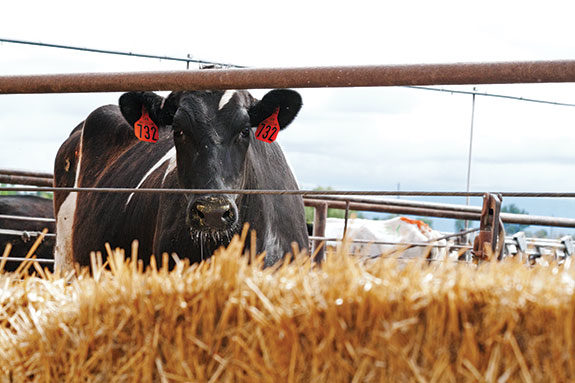The drought of 2012 left most farms, in a large part of the county, short on forage inventory either because they harvested less tonnage or their forage supplier has less tons to sell. Record-high replacement forage cost makes purchasing unpalatable or decreases already thin profit margins with higher feed cost.
I get asked many questions about strategies for stretching current forage inventories and economical ways to get adequate fiber levels into cows. My answer is simple: harvest it, buy it or stretch it.
Harvest extra forages
I still have dairymen harvesting forages. They are not traditional forages, but there has been a fair amount of soybean stubble, corn stalks and other crop residue harvested either as feed (if the quality is good enough) or as bedding materials so that the farm can free up traditional bedding material (primarily straw) for feed.
A few pounds of straw in the diet can replace several pounds of other forages in the ration, which helps to stretch current feed inventories.
Straw’s high NDF and its high buoyancy tendencies form an excellent rumen mat. These characteristics help maintain rumen integrity on low-forage diets when high levels of byproducts are fed, replacing needed forage dry matter (see below).
I have fed up to six lbs of straw in lactation diets without hurting peak milk and am routinely feeding two to four lbs this year to help stretch corn silage inventories.
Straw is also a relatively inexpensive forage and feeding a couple of pounds of $125-per-ton straw versus 3.5 pounds of $345-per-ton alfalfa hay saves around $0.27 per head per day in feed cost when fed at equal amounts of NDF (neutral detergent fiber) and CP (crude protein).
Early spring or summer harvest is another strategy to consider when short on current forage inventory. Small-grain crops such as triticale, rye, oats, barley wheat and spelts can all be harvested in early spring to add to your current forage inventory.
Keep an eye on a couple of new varieties of triticale and ryegrass that can be harvested in the fall and again in the spring or varieties that allow for multiple cuttings in the spring.
There are several varieties of spring barley, wheat and oats that can be planted in the spring and harvested in early summer for more forage tonnage. Seed inventories of these forages are in tight supply this year.
Early-planted sorghum/sudangrass (I much prefer the BMR types for lactating cow feed) can be planted in early summer and harvested in mid-summer, and multiple cuttings are commonplace.
Sorghum/sudangrass typically will not yield as much as corn silage, but the July harvest window may allow current inventories to stretch until regular fall harvest time.
Several farms have ordered very short-season corn to be harvested as corn silage weeks before their traditional harvest time to ensure they have enough corn silage tonnage to feed all season.
Buying forages
Price is set by supply and demand. Short supply and high demand brings high prices and this year’s forage crop is no exception. Hay prices pushing $400 per ton and corn silage pushing $100 per ton are not unheard of.
I encourage dairymen to be sure they are buying the best-quality product they can at those prices. Hay should be bought on high RFQ (Relative Feed Quality), which accounts for NDF digestibility and not RFV (Relative Feed Value).
If you are looking to stretch forage inventory, consider buying a higher NDF grass or mixed hay for less money. If you are looking for a pound of NDF, you’ll need to feed 2.27 lbs of a 44 percent NDF alfalfa hay but only 1.67 lbs of a 60 percent NDF grass hay.
What’s a fair price? Pre-drought, I used $1.25 x point of RFQ x dry matter percentage to determine price per ton of hay and haylages. This year, that price is much closer to $1.75 per point of RFQ, but I look for that value to drop as we get closer to new-crop harvest.
Corn silage pricing is a bit more complicated. There is the old formula of the local corn price x 7 + harvest cost = price per ton of 35 percent dry matter corn silage ($7.00 x 7 = $49 + $12 = $61 per ton). Silage dry matter differences can be adjusted for by a simple percentage.
If the corn silage is 30 percent DM instead of 35 percent, then multiply the silage price by 86 percent (30 percent / 35 percent x $61 = $52.46 per ton). Because the price of corn has risen dramatically the past couple of years, the value of corn silage has followed suit and newer equations include the value of the starch in the corn silage.
There are several detailed spreadsheets available online at different websites that takes the starch content, drying shrink, shelling cost and trucking into account. You need a computer and a half-hour to use them.
I carry a calculator and have a few minutes, so I like the simple equation that uses the local corn price and the local price of a low-protein grass hay to figure roughly what the corn silage is worth.
First, take a ton of wet corn silage and convert it to pounds of dry matter (2,000 lbs x 35 percent DM = 700 lbs of DM). Take this value and multiply it by the corn silage starch percent to get pounds of starch in that amount of dry matter (700 lbs DM x 32 percent = 224 lbs of starch).
Next, subtract the pounds of starch from the original dry matter total to get the pounds of the grass hay needed to make up the total dry matter pounds (700 lbs DM – 224 lbs of starch = 476 lbs of grass hay).
Then, calculate the cost per lb of both local corn and grass hay ($7.00 per bu / 56 lbs per bu = $0.125 per lb and $200 per ton / 2,000 lbs = $0.10 per lb). Take these costs per lb and multiply them by the pounds of dry matter of both the starch and grass hay needed that you just calculated (starch 224 lbs x $0.125 = $28, grass hay 476 x $0.10 = $47.60).
Finally, add these two numbers together and you get what a ton of wet corn silage is worth ($28 + $47.60 = $75.60 per ton). The fact that corn is about 70 percent starch offsets the shrink, shelling cost and harvest cost in other calculations – and is why you do not correct for it.
Stretching forages
The last option is to stretch the inventory you have by feeding less of it and replacing forage with byproducts and other feedstuffs. Whole fuzzy cottonseed, citrus pulp, almond hulls, beet pulp, cottonseed hulls and cottonseed burrs are all traditional forage replacement feeds.
These feeds are high in NDF and contribute to the rumen fiber mat, helping to maintain healthy rumens. Feeds like corn gluten feed, wheat midds, mill run, distillers and soyhulls, while high in NDF, add little to the rumen mat.
However, they do replace more fermentable carbohydrates in the diet, allowing a lower-forage diet to be fed without risking rumen upsets.
Care needs to be taken when balancing low-forage diets, and a fairly sophisticated ration balancing program should be used. Ration programs that just balance on chemical NDF might underpredict rumen health parameters and result in rumen upsets, lower butterfat and increased incidents of sore feet.
With the high price of purchased forages, adding byproducts typically lowers feed cost and is why it is the most popular choice among dairymen today. PD
Photo by PD staff.

Steve Massie
Western Field Nutritionist
Renaissance Nutrition, Inc







